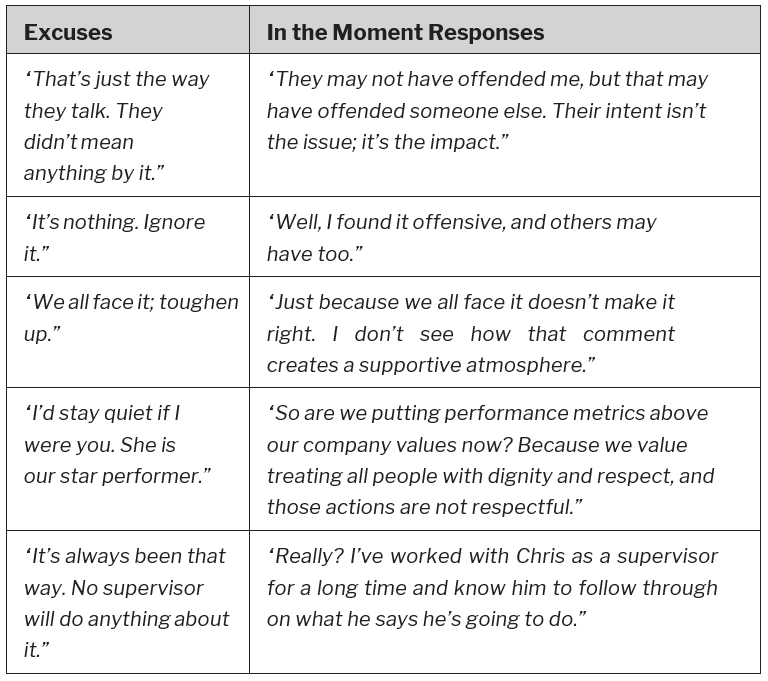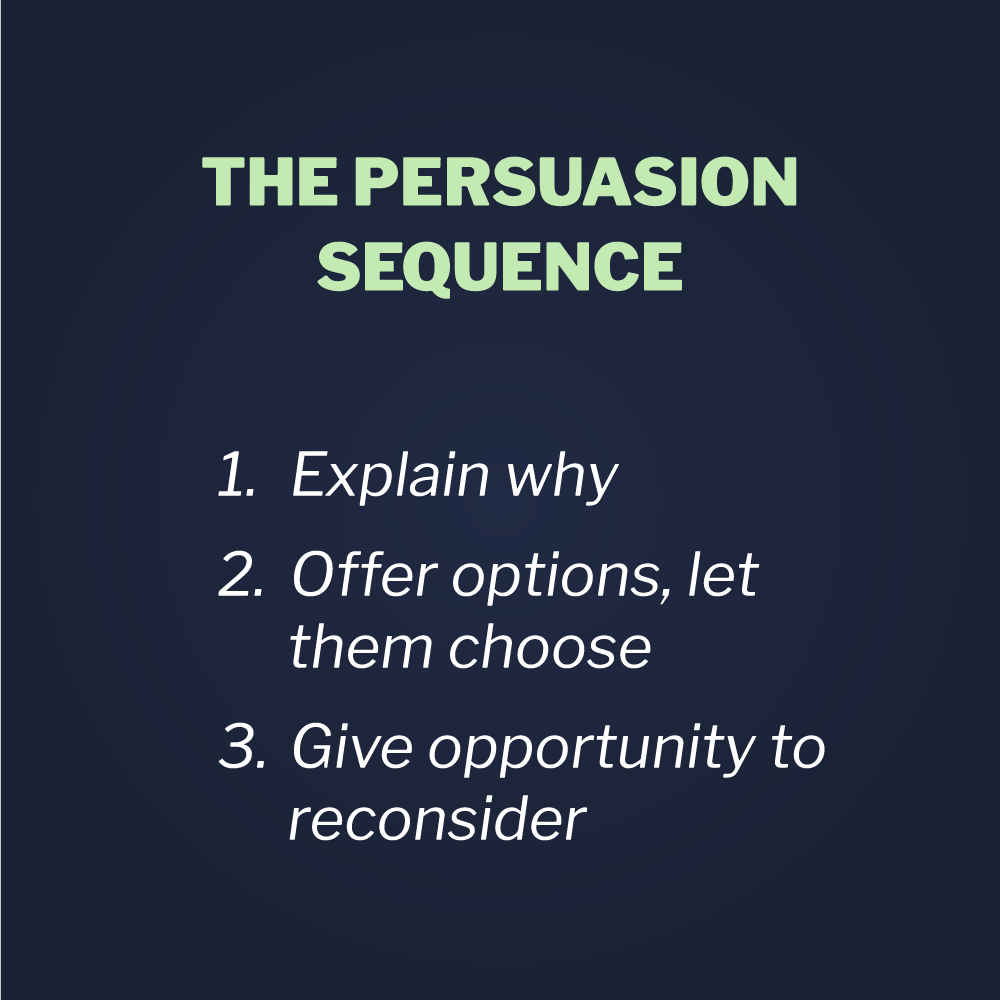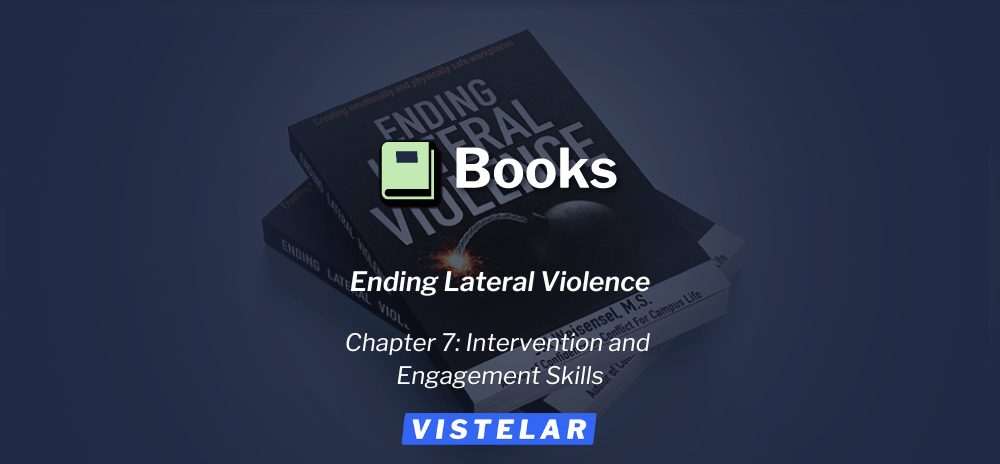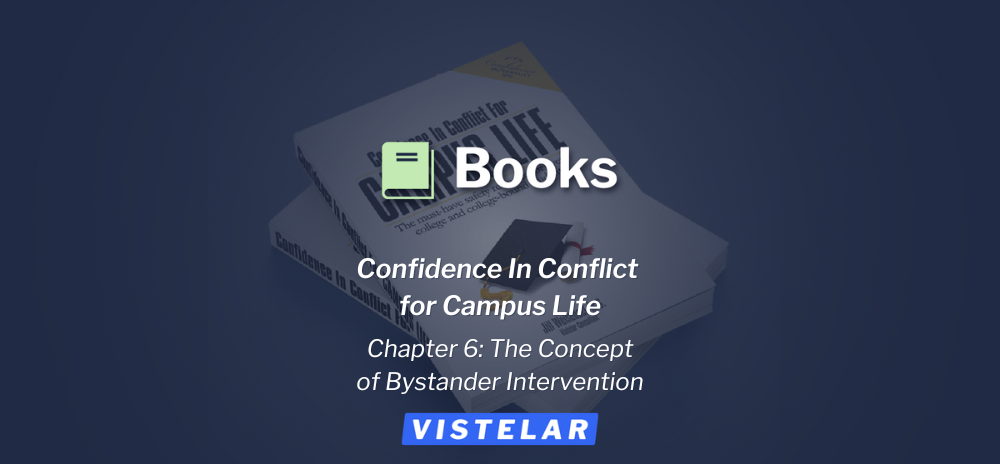Enjoy this excerpt from one of our published books.
Chapter 7
Intervention and engagement skills
More often than not, the intervention needed in a laterally violent scenario will be low level (meaning, not physical). Therefore, bystander intervention moments are less often about what to “do” and more often about what to “say” and when.
One of the most undervalued elements of intervention and delivery is timing. You must first consider your headspace, their headspace, and if there is enough time available to have the difficult (but respectful) conversation.
The following engagement skills will help you intervene simply by communicating at an appropriate interjection point.
Consider and apply these foundational elements of delivery style:
- To whom you say it (your audience).
- What you say (the content, your word choice).
- When you say it (timing).
- Where you say it (the location).
- Why you say it (by presenting your evidence, reasoning, desired outcome).
- How you say it (your pace, pitch, tone, inflection).
- How you look (non-verbal communication).
Remember, it is not just about what you say; it is about understanding what you are trying to do with what you say or the outcome you’re looking for. People generally remember the impact (how you made them feel) instead of your intentions (regardless of how well- intended you were).
At the point of impact, it is possible that the other person will react irrationally. During times of irrationality, we tend to focus more on non-verbal behaviors, so your non-verbal messaging may be all that gets through. This is why communication alignment is critically important.
Non-verbal communication plays five roles:
- Repetition: It can repeat and often strengthen your verbal message.
- Substitution: It can substitute for a verbal or oral message. For example, your facial expression often conveys a far more vivid message than words ever can.
- Complementing: It can add to or complement your verbal message. As a boss, if you pat an employee on the back in addition to giving praise, you may increase the impact of your message.
- Accenting: It can accent or underline a verbal or oral Pounding the table, for example, can underline the importance of your message.
- Contradiction: It can contradict the message you’re trying to convey, thus indicating to your listener that you may not be telling the For this reason, you want to avoid non-verbal gestures that contradict your intended message.
In addition to the information above, it is crucial to understand that any nuance in your rate of speech, pitch, volume, or tone will give those sentences different meanings. For example, the inflection or tone you put on a word will reflect your attitude, opinion, or bias, potentially converting a sentence from a gesture of support to insulting.
Use professional language to achieve a professional objective. It is the shorter report way, the lower liability way, the fewer lawsuits way, the higher retention way, and the more humane and ethical way.
The Language of Engagement: Using Word-Based Methods to Intervene
“Is this a private fight, or can anyone join?”
– Olde Irish saying
Now that you have a better understanding of the role of non- verbal communication and delivery style in intervention, we can take a closer look at what to say, when to say it, and how to say it. Having pre-practiced phrases in mind will help you know what to say at the point of impact. Engagement phrases, redirections, and persuasion are three word-based tools that will help you, even during the most stressful of situations.
Engagement Phrases
Engagement phrases are phrases you can use to quickly intervene, get someone’s attention, or divert a conversation. Effective engagement phrases need to be short (remember the economy of words) and long enough to tactfully get your point across without escalating the situation.
In order for an engagement phrase to be effective, you have to ensure that your word choice and delivery style match your intended message. This will ensure that the engagement phrase is delivered in a way that is non-accusatory and non-judgmental. A slight alteration in your word choice alone can create a different impression and have a much different impact.
For example:
- Instead of saying, “Stop yelling,” try saying: “Take a deep breath and then tell me what happened.”
- Instead of saying, “Be quiet,” or “Shut up,” try saying: “Could you please use a softer voice?”
- Instead of saying, “What’s wrong with you?” try saying: “What did I miss that has you feeling this way?”
Here are additional examples of common engagement phrases:
- “This is ABC Organization. That is not what we are”
- “You may not have offended me, but your words/actions/ behaviors may have offended someone else.”
- “I understand that you have every right to feel angry, but it is not okay for you to threaten me or others.”
- “Could you please clarify what you just said? I’m not sure I understood that correctly.”
- “Do you really feel that way about ‘x’ person/group/ behavior?
- “I didn’t expect that from ”
- “Really?”
- “You have always done a good job, and I appreciate ”
- “We’ve always been able to work things out in the ”
- “Could you please find a respectful way to ask/say that?”
- “I understand you’re upset; I hear I’m here now, and I want to help.”
- “I’m here to help, and if I can’t help you, I will find you someone who can. Okay?”
- How can I help/how can we fix this if you keep yelling at me?”
- “Could you please explain to me what is going on from your perspective/as you see it?”
- “Right now, this is a small issue; let’s work together so it doesn’t become ‘x.’”
- “That didn’t necessarily offend me, but it may have offended someone else.”
- “Hey now, take it You didn’t really mean that, did you?”
- “Could you please choose/use another word?”
- “Hey, we’re friends, right? Could we please talk about …”
- “Let’s think about that for a second.”
There are a few other things to keep in mind when delivering engagement phrases:
- Avoid using words like “sir” or “ma’am” to eliminate the tension and avoid the awkwardness of misidentifying someone or setting off gender triggers.
- Remember the precision of word choice. Make sure you say what you mean and mean what you Words mean different things to different people.
- Consider using the phrases in combination, as part of a redirection, or to build context as part of the persuasion
- Empathize with their feelings, not their inappropriate
Redirection
Redirection is a method taught in the Vistelar Non-Escalation, De- Escalation, and Crisis Management training program used to de-escalate verbal resistance (such as shouting, ranting, or refusal) or a verbal assault (insults or direct verbal attacks) in a way that allows you to bring the conversation back to the issue at hand. The goal of using a redirection is to prevent a verbal confrontation from escalating further. Here is an example:
Acknowledge the comment → Back to the issue
With this redirection, you acknowledge the other person’s comments with a statement like, “I can appreciate that,” “I hear you,” “I got that,” or “I see,” and then structure your next statement(s) to get back to the issue at hand.
Here are a few examples:
- “I hear you; however, we have an issue to Can you work with me here?”
- “I appreciate that you have had problems in the However, you haven’t worked with me before. Let’s see what I can do to help.”
- “Is there something I did to make you angry? I apologize if I did something wrong, but can you please not swear at me so we can resolve this?”
In using the redirection method, do not concern yourself with the other person’s abusive comments or dismissal. Your job is not to fix their attitude; it is to change their behavior.
In looking at the application of engagement phrases and redirections, let’s revisit a few of the common excuses for inappropriate behavior mentioned earlier:

Persuasion
Persuasion is another method taught in the Vistelar Non-Escalation, De-Escalation, and Crisis Management training program used to achieve cooperation, collaboration, or consensus while avoiding escalation to a verbal or physical confrontation.
Persuasion works best when you:
- Are respectful.
- Provide solid reasoning.
- Appeal to their emotions.
Being respectful is accomplished by starting every interaction with a universal greeting, and listening rather than talking. Since people are more likely to agree or cooperate with people they like, trust, and view as credible, being respectful is the most powerful contributor to persuasion. You should not begin persuasion until you have introduced yourself with a universal greeting and listened to their answer to the relevant question (Step 4 directly below):
To use the universal greeting:
- Use a (neutral) appropriate greeting (such as “hello”).
- State your name and affiliation (who you work for and your role).
- State the reason for the contact (explain why you are talking with them).
- Ask the relevant question (explain why you are speaking with them).
Here is an example of what this sounds like in action:
“Hello. My name is Heyden, and I’m the manager here. I overheard you swearing quite loudly in the lobby on your phone call. Could you please keep your voice down and choose more respectful language?”
(Please note that this is just one application example of the universal greeting. The relevant question does not have to be a compliance- related question, but in this particular case, it is.)
If the person you have approached does not cooperate, verbally resists, or insults you, then you would proceed to using persuasion. The three-step persuasion sequence provides an opportunity to appeal to their logic and emotions, and it works like this:
-
State the reason for your request (usually due to a law, policy, rule or prior agreement),
-
Explain the rationale for the reason, and
-
Then ask if they understand the explanation.
Using the example from above, it would sound like this:
“Our policy is to create and maintain an emotionally and physically safe environment for everyone, and loud shouting and swearing goes against that policy because it frightens people. Does that make sense to you?”
If the person pushes back, refuses, or delivers a personal or organizational insult, proceed to the next step.
2. Offer options, and let them
Start by offering them a positive option. Make sure you sound positive and upbeat, almost as if you are advocating for them and this choice. Then follow up by offering a less desirable option, and make sure you deliver it in a way that it doesn’t sound like a threat. Then, empower them to decide.
Using the example from above, it would sound like this:
“I understand that you are frustrated. However, we have some good options here. It’s a beautiful day out, and there’s an outdoor public waiting area just outside that door. You’re more than welcome to go enjoy some sun and make that phone call outside. However, if you’re unwilling to step outside to that courtyard, and you’re unwilling to stop shouting and swearing, I will have to ask you to leave the premises. Given that you drove a long way to get here, I’m sure there’s a good reason for your visit, and I know your time is valuable to you. Are you willing to work with me here and just finish that phone call outside in the courtyard?”
If the person continues to push back, refuses, or delivers a personal or organizational insult, proceed to the next step.
3. Finally, give them the opportunity to reconsider.
Give them a chance to save face while reminding them why cooperation is the best course of action.
Here is an example of what this sounds like in action:
“I understand your frustration, and if I were in your position, I might be too. I know you just want to vent, and I’d love for you to be able to do that – outside – and in private. Is there anything I can say to get you to change your mind?”
If the other person has not cooperated after this third step, your options will vary depending on the situation, and it is important that you know what the next course of action is. In this case, it may be the need to call security, or perhaps a different staff member could come and try and talk to the individual.
What if Word-Based Methods Fail?
Non-escalation and de-escalation are about employing different strategies toward a desired result: reducing intensity, conflict, or a potentially violent situation. However, de-escalation must be understood as a process, not a particular outcome, and even if you do everything “right,” word-based methods alone may not be enough to resolve the situation.
Despite our best efforts:
- The persuasion sequence can end without cooperation (as explained in the example above), or
- A clearly articulable safety concern could justify taking some other action (such as the person increasing aggression or displaying at-risk or harmful behavior to themselves or others).
When either of these criteria is met, you must take appropriate action, which includes these two steps:
- Know your options for taking action (which will vary depending on your role in the organization), and
- Have a pre-planned response to situations you will likely face (by using when-then/thinking scenarios).
If you identify safety risks, notice pre-incident indicators, are exposed to gateway behaviors, or if word-based methods fail, your best option might not be to engage but to leave, to call a supervisor, or worst-case scenario, possibly security or 911. If you believe some form of physical engagement could occur, leave via a predetermined escape route.
After Action Considerations: Closure, Debrief, and Documentation
If you were or are involved in any form of incident, there are several after-action considerations to keep in mind, including incident closure, debriefing, and documentation.
First of all, Closure is a method taught in the Vistelar Non-Escalation, De-Escalation, and Crisis Management training program for ending all interactions safely and on a positive note, regardless of how negative the event may have been. It also helps build a better foundation for any possible future interactions.
Here are a few reminders related to closure
- Practice empathy: Gather information; act based on how you would feel if you were in the exact same situation; show respect and demonstrate concern. Consider giving a post- incident Universal Greeting and reintroduce yourself now that emotions have settled.
- Respond, don’t react: Maintain emotional equilibrium, and pay attention to proxemics, non-verbals, verbals, and para-verbals.
- Exhaust all reasonable attempts to resolve refusals: De-escalate resistance, manage crisis, and ensure everyone is safe.
- Acknowledge that things may not have gone as either of you would have liked and state that you are hopeful for a more positive interaction in the future.
Secondly, you need to debrief the incident with others. This could include anyone who witnessed the event, assisted with the intervention, managers, or any other personnel associated with the after-action review process.
Debriefs are highly valuable because they:
- Help those involved decompress and can reduce the possibility of psychological harm by talking about what has happened.
- Set the tone for learning and improved team response.
- Create space where facts can be reviewed and misconceptions about the incident can be corrected.
- Focus on what was learned from the incident that should be used (or avoided) in the future.
- Help streamline internal and external processes or policies.
Additionally, in the event of a serious incident, such as a physical assault or the need for physical intervention, a formal (or administrative) post-incident review will likely evaluate the reasonableness of the actions taken and will be evaluated in relation to:
- The totality of the circumstances,
- Your training and experience (the perspective of a reasonable person in a similar position),
- Who was on the scene,
- At the moment the decision was made,
- Without 20/20 hindsight, and
- In circumstances that are often tense, uncertain, and rapidly evolving.
These six elements are critical in assessing actions taken during an incident and are directly from the 1989 U.S. Supreme Court decision (Graham v. Connor).
Additionally, your actions may be evaluated in relation to the nature or severity of the offense, if the person displayed active resistance, or if their actions posed an immediate threat to you or someone else. These are known as the Graham Factors, and for this reason, you will need to show both proper and legal decision-making and the proper articulation of the event. This means you will have to be able to explain why you did what you did when you were within policy and the law to do so. “Reasonable action” for some may seem quite different to someone facing an aggressor in the moment than to someone just analyzing the situation after the fact and at their leisure (this point was flushed out in the 1992 Circuit Court decision (Smith v. Freland 1992).
Finally, if you were or are involved in any form of a reportable incident, file a report according to your organization’s policies and procedures. This will be covered more in-depth later in the book.
Such reports will typically include a description of the incident, your attempt to manage it, and the outcomes of the incident.
In deciding what to report, consider a reportable lateral violence incident as any attempt to emotionally, socially, or economically harm another.
It’s important to note that incidents of lateral violence are often underreported for a variety of reasons, including:
- There is not a consistent organizational definition of
- There is a pervasive acceptance of threatening behavior and violence as part of the job.
- There is a belief that a threat of violence is not significant enough to report.
- Employees may be embarrassed and hesitant to report violent behavior.
- Employees may feel they don’t have the time to write a
- Employees may fear accusations of incompetence or think their employer might assume they were the cause of the violence.
- There is a lack of supervisor
While avenues for reporting are organization-specific, the importance of reporting cannot be understated. In order for a problem to be addressed, people must be aware of its existence. It is critical to have records in place that will help the employer understand the extent of the problem(s), investigate them, and take actions to stop the behaviors from happening again in the future.
Work with your human resources personnel to ensure that your organization has a confidential and centralized reporting system in place with anonymous reporting options. Reference the Vistelar Workplace Violence Prevention and Intervention training program for more information (please refer to the section titled “Who is Vistelar” at the end of the book).
Key Takeaways
Bystander intervention moments are less often about what to “do” and are more often about what to “say” and when to say it.Consider and apply these foundational elements of delivery style:
- To whom you say it (your audience).
- What you say (the content, your word choice).
- When you say it (timing).
- Where you say it (the location).
- Why you say it (by presenting your evidence, reasoning, desired outcome).
- How you say it (your pace, pitch, tone, inflection).
- How you look (non-verbal communication).
- Engagement phrases are non-judgmental and non- escalatory phrases that can get someone’s attention or divert a conversation.
- Redirection is a quick and effective method of turning a conversation back towards a professional goal.
- Persuasion is a de-escalation method for gaining cooperation or collaboration.
- Closure is a method of ending interactions safely and on a positive note and sets the foundation for future
- Debriefing is important for reducing the possibility of psychological harm by talking about what has
- Appropriate and thorough documentation helps the employer understand the extent of the problem(s), investigate them, and take actions to stop the behaviors from happening again in the future.









